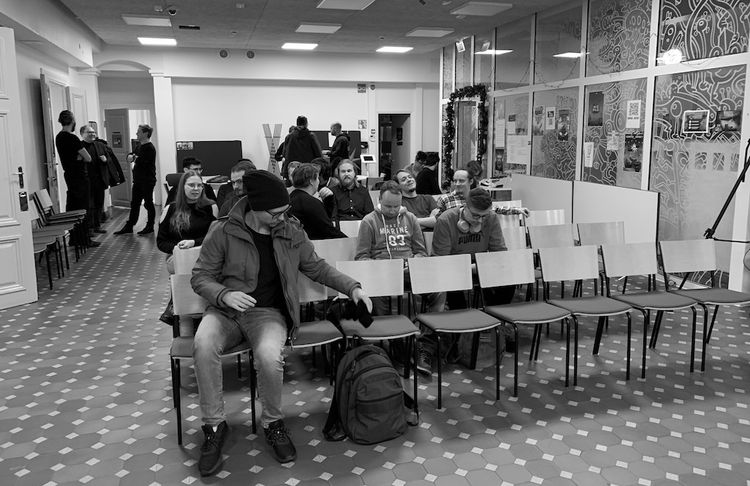Teams and Team Building In Gaming

Notes
- Joakim’s experience in team building
- Founding team
- Why do I need a team? Why not start alone?
- Ironstar example
- What the process looked like for me in 2012?
- Me as the product person
- My brother as the AD
- Jaakko as client
- Kalle as CTO
- Teemu as CEO
- How did I learn what I needed for team building for Next Games
- Observed the founding team at Supercell
- What skills were in the team
- CEO + Creative Director + three tech people (no specific CTO) + artist
- If I would start to build a founding team
- I know my skills and experience
- What do I want to do? What are my ambitions?
- Reach out to my LinkedIn and Facebook contacts
- What would be the best people who are complementary to my skills
- Dream team
- What does the dream team give you?
- People who have to build and sell stuff on the A-class level
- Instant access to capital, before you even start pitching
- It’s the primary reason why gaming startups get funding
- If you can’t build the dream team?
- Start thinking about the skills
- Bring in learning machines
- Product + data + creative
- Tech
- Product + data + creative
- Pie chart
- Product
- Vision holder
- Describe what success looks like. Own the process of getting there.
- Describe all the failure situations. How will you navigate through those failures?
- Being on top of things. How do you understand what’s going on?
- Define these for your startup.
- Data
- What data is relevant
- If you come from outside gaming, you can look at data, but you won’t know where to start
- Let’s take a minute to look at the Growth Mindset
- Growth Mindset
- Creative
- Can think outside the box
- Sees what matters to the player
- If doing f2p, knows why the best f2p games keep making money for years
- Tech
- Full-stack devs
- Lots of experience
- Appetite for entrepreneurship
- Team building
- What is applicable for hires past the founding team?
- The same things really!
- Let’s expand on that.
- Personality traits
- Nice people
- Honest people
- ”You don’t have to be the leader to be a leader”
- Taking a pay cut, lifestyle downgrade
- Works well in a team
- Hiring for a culture
- Patrick Collison from Stripe: “Before you make an offer to someone, think about whether you’d like to have 10 times as many people as you in your company.” This is simple, good advice: the people you hire early on will be hiring the people in their teams, and people tend to hire people like them. This extra test help make a decision when you have mixed feelings about a candidate.
- Hire slow, fire fast
- Brilliant jerks
- “It’s better to have a hole in your org. than an asshole.“ It’s a great catchphrase of hers and is important to keep in mind: we tend to overestimate the negative impact of letting go of someone and ignore the damage done by leaving things as they are. Yes, letting go of someone might shake up the team for a moment, but a couple of weeks later your company will be in a better place, and everyone should see the value of the decision by then.
- Otherwise, you can start creating a toxic environment
- CEO
- Start building a leadership team
- You might need to expand from your founding team
- In gaming, we often have CPO and CTO
- But we don’t start with a CMO and a CFO
- Give trust to others
- Ownership
- Bottoms-up culture or people-first culture
- People-first cultures
- Are more inspiring for employees and customers alike.
- Helping an organization change not only their mindset but also their systems and processes to create a people-first organization isn’t easy.
- That complex diagram, coupled with a desire for “quick results” would likely not equal long-term progress (see HOW: Focus on the long term). Simon expressed his concern and asked the leader what he meant when he said “quick results.” If the board wanted to see things trending in the right direction in the first few months, Simon felt they might be able to find some leading metrics.
- “Will Luton: Which is this idea that sometimes when you say to people in a culture like your team that says really great, we go out for a beer on Friday. We play foosball. We play board games. And that’s, you know, those are so social likes superficial perks. They’re not actually what culture is, which is the way in which people interact with each other on a daily basis. Joakim Achren: Yeah, it’s the shiny office and everything.”
- On team and individuals: Daniel Ek:
- ”I haven’t done a lot of these interviews because I don’t believe Spotify is about any one individual. I don’t want to diminish my role, but in almost all innovations, it’s the collaboration of the team that creates something in a creative process that’s hard to capture. What often happens, people simplify the process and put it on one person who then looks like they’re some sort of demigod, infallible, up until the moment when they’re not and then the whole world collapses. I have some strengths but I have a lot of weaknesses, too. I wanted you to hear that directly from me.”
- What is your job? Really, what is your job?
- What are the tools?
- #1 All-hands
- Communicate
- Constant dialogue, measure where you are
- Are we building a game or a company?
- What do we want to achieve?
- What is our ambition?
- Asking your employees “What do you suspect the reason we will fail will be?” is extremely valuable too. They have all the inside knowledge. Makes for a great 1:1 too to unearth major issues. If you can, especially ask the employees to leave the company as well.
- #2 One-on-ones
- Mathilde says that ”If done effectively, these one-on-ones are an opportunity to show my team that I care about them, their professional success, and their overall happiness. It gives them an opportunity to step back and think about what they need, to be successful, and to hold me accountable for setting them up for this success.”
- Have three different kinds of one-on-ones
- Weekly one-on-ones between manager and employee.
- Both discuss how progress has been made, look to unblock any issues and to ask and answer questions. The goal of this one-on-one is to ensure that people are working on the right things and that they understand why their work matters to the business.
- Monthly one-on-ones between managers and employees are for a pulse check on happiness.
- There is a survey sent out a few days before the one-on-one, asking what the employee is happy and unhappy about what they’d like to be better at, what are they proud about, etc. The manager reads the responses a day before one-on-one in order to prepare for the meeting.
- Career development one-on-one
- Every six months, the manager and employee meet up for a discussion on career development. The questions here are around the employee’s current role, what kind of careers they admire, and where they want their careers to be in 6 months, 2 years, and 5 years’ time. The manager and employee work together to identify growth opportunities, and they both commit to the next steps of the employee’s desired career path.
- #3 Vision and mission
- Often something that gaming companies start worrying about when they hit twenty people
- The earlier you start, the better you will be off?
- Why?
- Vision and mission determine why the company exists
- Where do you want to be in three years? Describe that and you have your vision.
- Then work backward to see how to get there?
- Why it matters to small companies?
- An individual will have a reason to get out of bed in the morning
- The main reason for failure: giving up
- Why give up?
- Not seeing progress
- Game failing to become a commercial success or even viable business
- If you have a mission, a just cause, a belief bigger than you, you will continue
- Not to confuse with product
- Please do not confuse it with your Product’s Mission and Vision. There are many companies nowadays that have more than one product being developed or maintained and it is really important to have mission and vision defined for each of them.
- #4 Pixar’s BrainTrust (wrote about this recently)
- “How do you get a director to address a problem he or she cannot see?”
- In Catmull’s book, he wrote, “A mystifying plot twist or a less-than-credible change of heart in our main character is often caused by subtle, underlying issues elsewhere in the story.” The Brain Trust will point to an issue and then allow the director to figure out the problem on his or her own. Most importantly, of course, is that the film is under review, and not the filmmaker.
- “hallmark of a healthy creative culture is that its people feel free to share ideas, opinions, and criticisms”
- “The Braintrust meets every few months or so to assess each movie we’re making. Its premise is simple: Put smart, passionate people in a room together, charge them with identifying and solving problems, and encourage them to be candid.”
- “The Braintrust has no authority. The director does not have to follow any of the specific suggestions. After a Braintrust meeting, it is up to him or her to figure out how to address the feedback.”
- Why a BrainTrust is useful
- Again, now for a product owner / Game Lead: “How do you get a director to address a problem he or she cannot see?”
- As a company grows, the schedule (that is, the need for product) drives the output, not the strength of the ideas at the front end.
- Candor: In a 1–1 environment, we are usually open. But when we are in a group, our animal instincts start to kick in, and fear takes over. We want to secure a good opinion that everyone likes, and not be the rebel in the room. As Catmull has confirmed, “You are not your idea, and if you identify too closely with your ideas, you will take offense when challenged.”
- “Candor could not be more crucial to our creative process. Why? Because early on, all of our movies suck. That’s a blunt assessment, I know, but I choose that phrasing because saying it in a softer way fails to convey how bad the first versions really are.”
- How to apply a BrainTrust into gaming?
- “To start your own Brain Trust, Catmull recommends choosing people that make you think smarter, putting lots of solutions on the table and finding people who will level with you.”
- “The Braintrust is made up of people with a deep understanding of storytelling, who usually have been through the process themselves.”
- Start with game designers and product people, then carefully expand. “the Braintrust evolved from a tight, well-defined group working on a single film into a larger, more fluid group. Over the years, its ranks have grown to include a variety of people–directors, writers, and heads of story–whose only requirement is that they display a knack for storytelling”
- Why it can be hard to uphold a BrainTrust?
- You need someone owning the BrainTrust: “While I attend and participate in almost all Braintrust meetings, I see my primary role as making sure that the compact upon which the meetings are based is protected and upheld.”
- “you can’t totally eliminate the blocks to candor. The fear of saying something stupid and looking bad, of offending someone or being intimidated, of retaliating or being retaliated against–they all have a way of reasserting themselves. And when they do, you must address them squarely.”
- #5 Crunch Policy
- “we’re not going to crunch and then you anyways crunch?”
- things will come up that you never anticipated and things will take longer than you thought. you project plan, you always forget something
- outcomes projects discovered was that the best outcomes happened with the teams that had the least amount of crunch, and that they were self directed. So they came from teams that wanted to do it.
- There might be periods where people will work late and I want to be excited about something and there may be times when they come in late and they seem a bit disinterested. It’s impossible to find alignment with the whole team. they have different cycles, they wake up and they sleep at different times they sleep for, you know, longer, shorter periods of time. And all of these have an impact on the way they work and the type of work they can do and how long they can do it for.
- How to get rid of the crunch? Don’t do big bang launches. This is a big positive in mobile games, as UA driven game development as removed the reliance of App Store featuring which happens when the game is launched.
- But you also lose the sense of urgency.
- But the crunch will cause burn out, people leaving the company, and eventually even leaving the industry.
- #6 Financial incentives
- Salary and stock options
- Having a financial, big financial bonus could actually be detrimental because it changes the motivation, all of a sudden you then start to think perhaps more derivatively, you’re not thinking as collaboratively as you could be.
- For creative work, financial bonuses aren’t that effective. It’s difficult to tie in.
- Salary and stock options. Be as transparent as possible. Why you have a certain salary and why certain people get the stock options. Talk about them as early as possible. Share them with people in the hiring process.
- If you hire someone from a bigger games company, who you are willing to pay a bigger salary to, you should bump up the pay of their peers.
- Transparency is so important because people will talk about salary. Same with stock options.
- Take a look at what Buffer does https://open.buffer.com/introducing-open-salaries-at-buffer-including-our-transparent-formula-and-all-individual-salaries/
- #7 Safe environment
- Vulnerability, what does that mean?
- what vulnerability means is you create an environment in which someone feels safe enough to raise their hand and said, ”I don’t know what I’m doing.”
- Leaders should practise empathy: Instead of asking ”How do I get the most out of my people”, ask ”How do I help my people be at their natural best”
- Make Sure the Leader Is Vulnerable First and Often As Dave Cooper says, I screwed that up are the most important words any leader can say.
- Laszlo Bock, former head of People Analytics at Google, recommends that leaders ask their people three questions:
- What is one thing that I currently do that you’d like me to continue to do?
- What is one thing that I don’t currently do frequently enough that you think I should do more often?
- What can I do to make you more effective?
- Just ask for one answer.
- Overcommunicate ways of co-op. Talk about the expectations of cooperation. It won’t happen on it’s own. Define collaboration, helping others and model the expected vulnerability
- Deliver the negative stuff in person. If you have negative news or feedback to give someone—even as small as a rejected item on an expense report—you are obligated to deliver that news face-to-face. Creates understanding, clarity, and connection. One-on-one culture, and one-to-many
- In The Culture Code, Daniel Coyle talks about the two critical moments. When Forming New Groups, Focus on Two Critical Moments 1. The first vulnerability, and 2. The first disagreement. These small moments are doorways to two possible group paths: Are we about appearing strong or about exploring the landscape together? Are we about winning interactions, or about learning together?
Webinar video from April 2020
Did you enjoy this episode?
Here’s a few more episodes which are close to the topic.





